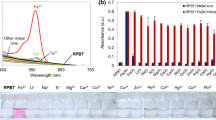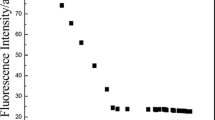Abstract
A rhodamine B-functionalized bis-polydiacetylene (RB/bis-PDA) film sensor was prepared. Rhodamine B derivatives as the ion-recognition elements were embedded in the bis-polydiacetylene matrix through the hydrolysis/condensation process of organic silicon. The as-prepared blue-phase RB/bis-PDA film could transfer to yellow phase at high temperatures. Upon dipping the blue and yellow RB/bis-PDA films into various metal ion solutions, respectively, only Al3+ could induce remarkable changes in absorption and color signals. The UV–Vis absorption spectrum of the Al3+-containing film showed two separate absorption peaks at 556 nm and at another wavelength (617 or 470 nm), corresponding to ring opening of the spirolactam structure in rhodamine moiety and PDA (blue- or yellow-phase PDA), respectively. Utilizing the different intensity ratios of the two absorption signals (A556/A617 or A556/A470), the RB/bis-PDA system could be used as a bis-ratiometric absorbance sensor for Al3+. The reusable and free-standing films have great potential in environmental and biological sensing fields as they are more convenient to achieve real-time sensing than the conventional probes dissolved in aqueous or organic solvents.














Similar content being viewed by others
References
Annadhasan M, Kasthuri J, Rajendiran N (2015) Green synthesis of gold nanoparticles under sunlight irradiation and their colorimetric detection of Ni2+ and Co2+ ions. RSC Adv 5:11458–11468. doi:10.1039/c4ra14034f
Chen X, Zhou G, Peng X, Yoon J (2012) Biosensors and chemosensors based on the optical responses of polydiacetylenes. Chem Soc Rev 41:4610–4630. doi:10.1039/c2cs35055f
Choi YW, Park GJ, Na YJ, Jo HY, Lee SA, You GR, Kim C (2014) A single schiff base molecule for recognizing multiple metal ions: a fluorescence sensor for Zn(II) and Al(III) and colorimetric sensor for Fe(II) and Fe(III). Sens Actuators B 194:343–352. doi:10.1016/j.snb.2013.12.114
Ding W, Wang D, Zheng X, Ding W, Zheng J, Mu W, Cao W, Jin L (2015) A turn-on fluorescence chemosensor for Al3+, F− and CN− ions, and its application in cell imaging. Sens Actuators B 209:359–367. doi:10.1016/j.snb.2014.11.144
Doussineau T, Schulz A, Lapresta-Fernandez A, Moro A, Körsten S, Trupp S, Mohr GJ (2010) On the design of fluorescent ratiometric nanosensors. Chem Eur J 16:10290–10299. doi:10.1002/chem.201000829
Fan J, Hu M, Zhan P, Peng X (2013) Energy transfer cassettes based on organic fluorophores: construction and applications in ratiometric sensing. Chem Soc Rev 42:29–43. doi:10.1039/c2cs35273g
Fan C, Huang X, Han L, Lu Z, Wang Z, Yi Y (2016) Novel colorimetric and fluorescent off–on enantiomers with high selectivity for Fe3+ imaging in living cells. Sens Actuators B 224:592–599. doi:10.1016/j.snb.2015.10.104
Gao M, Han S, Hu Y, Zhang L (2016) Enhanced fluorescence in tetraylnitrilomethylidyne-hexaphenyl derivative-functionalized periodic mesoporous organosilicas for sensitive detection of copper(II). J Phys Chem C 120:9299–9307. doi:10.1021/acs.jpcc.6b01837
García-Frutos EM, Fernández-Lázaro F, Maya EM, Vázquez P, Torres T (2000) Copper-mediated synthesis of phthalocyanino-fused dehydro[12]- and [18]annulenes. J Org Chem 65:6841–6846. doi:10.1021/jo0006019
Gensemer RW, Playle RC (1999) The bioavailability and toxicity of aluminum in aquatic environments. Crit Rev Environ Sci Technol 29:315–450. doi:10.1080/10643389991259245
Goswami S, Maity S, Maity AC, Maity AK, Das AK, Saha P (2014) A FRET-based rhodamine–benzimidazole conjugate as a Cu2+-selective colorimetric and ratiometric fluorescence probe that functions as a cytoplasm marker. RSC Adv 4:6300–6305. doi:10.1039/c3ra46280c
Hsu L, Cvetanovich GL, Stupp SI (2008) Peptide amphiphile nanofibers wit conjugated polydiacetylene backbones in their core. J Am Chem Soc 130:3892–3899. doi:10.1021/ja076553s
Hu Y, Xu R, Dynes JJ, Blyth RIR, Yu G, Kozak LM, Huang PM (2008) Coordination nature of aluminum (oxy)hydroxides formed under the influence of tannic acid studied by X-ray absorption spectroscopy. Geochim Cosmochim Acta 72:1959–1969. doi:10.1016/j.gca.2008.02.002
Jeon H, Lee S, Li Y, Park S, Yoon J (2012) Conjugated polydiacetylenes bearing quaternary ammonium groups as a dual colorimetric and fluorescent sensor for ATP. J Mater Chem 22:3795–3799. doi:10.1039/c2jm14996f
Jiang H, Jelinek R (2016) Hierarchical assembly of polydiacetylene microtube biosensors mediated by divalent metal ions. ChemPlusChem 2016:119–124. doi:10.1002/cplu.201500405
Karimi M, Badieia A, Ziarani GM (2016) Fluorescence-enhanced optical sensor for detection of Al3+ in water based on functionalised nanoporous silica type SBA-15. Chem Pap 70:1431–1438. doi:10.1515/chempap-2016-0079
Kim TH, Lee BY, Jaworski J, Yokoyama K, Chung WJ, Wang E, Hong S, Majumdar A, Lee SW (2011) Selective and sensitive TNT sensors using biomimetic polydiacetylene-coated CNT-FETs. ACS Nano 5:2824–2830. doi:10.1021/nn103324p
Kim C, Hwang JY, Ku KS, Angupillai S, Son YA (2016) A renovation of non-aqueous Al3+ sensor to aqueous media sensor by simple recyclable immobilize electrospun nano-fibers and its uses for live sample analysis. Sens Actuators B 228:259–269. doi:10.1016/j.snb.2016.01.020
Ku KS, Muthukumar P, Angupillai S, Son YA (2016) A new rhodamine 6 G based chemosensor for trace level Al3+ and its thin film application in 100% aqueous medium. Sens Actuators B 236:184–191. doi:10.1016/j.snb.2016.05.143
Li K, Zang Y, Wang H, Li J, Chen G, James TD, He X, Tian H (2014a) Hepatoma-selective imaging of heavy metal ions using a ‘clicked’ galactosylrhodamine probe. Chem Commun 50:11735–11737. doi:10.1039/c4cc04568h
Li T, Fang R, Wang B, Shao Y, Liu J, Zhang S, Yang Z (2014b) A simple coumarin as a turn-on fluorescence sensor for Al(III) ions. Dalton Trans 43:2741–2743. doi:10.1039/c3dt52414k
Li S, Zhang D, Xie X, Ma S, Liu Y, Xu Z, Gao Y, Ye Y (2016a) A novel solvent-dependently bifunctional NIR absorptive and fluorescent ratiometric probe for detecting Fe3+/Cu2+ and its application in bioimaging. Sens Actuators B 224:661–667. doi:10.1016/j.snb.2015.10.086
Li Z, Li H, Shi C, Zhang W, Zhou W, Wei L, Yu M (2016b) Naked-eye-based highly selective sensing of Fe3+ and further for PPi with nano copolymer film. Sens Actuators B 226:127–134. doi:10.1016/j.snb.2015.11.105
Lu Y, Yang Y, Sellinger A, Lu M, Huang J, Fan H, Haddad R, Lopez G, Burns AR, Sasaki DY, Shelnutt J, Brinker CJ (2001) Self-assembly of mesoscopically ordered chromatic polydiacetylene/silica nanocomposites. Nature 410:913–917. doi:10.1038/35073544
Lu Y, Huang S, Liu Y, He S, Zhao L, Zeng X (2011) Highly selective and sensitive fluorescent turn-on chemosensor for Al3+ based on a nove photoinduced electron transfer approach. Org Lett 13:5274–5277. doi:10.1021/ol202054v
Ma B, Wu S, Zeng F (2010) Reusable polymer film chemosensor for ratiometric fluorescence sensing in aqueous media. Sens Actuators B 145:451–456. doi:10.1016/j.snb.2009.12.054
Mahapatra AK, Maiti K, Maji R, Manna SK, Mondal S, Ali SS, Manna S (2015) Ratiometric fluorescent and chromogenic chemodosimeter for cyanide detection in water and its application in bioimaging. RSC Adv 5:24274–24280. doi:10.1039/c4ra17199c
Manjare ST, Kim Y, Churchill DG (2014) Selenium- and tellurium-containing fluorescent molecular probes for the detection of biologically important analytes. Acc Chem Res 47:2985–2998. doi:10.1021/ar500187v
Narkwiboonwong P, Tumcharern G, Potisatityuenyong A, Wacharasindhu S, Sukwattanasinitt M (2011) Aqueous sols of oligo(ethylene glycol) surface decorated polydiacetylene vesicles for colorimetric detection of Pb2+. Talanta 83:872–878. doi:10.1016/j.talanta.2010.10.054
Pawar S, Akula M, Labala S, Venuganti VVK, Bhattacharya A, Nag A (2016) Zinc(II) ion sensing in aqueous micellar solution using modified bipyridine-based “turn-on” fluorescent probes and its application in bioimaging. ChemPlusChem 81:1339–1348. doi:10.1002/cplu.201600382
Qiu X, Han S, Hu Y, Gao M, Wang H (2014) Periodic mesoporous organosilicas for ultra-high selective copper(II) detection and sensing mechanism. J Mater Chem A 2:1493–1501. doi:10.1039/c3ta14314g
Qiu X, Han S, Hu Y, Sun B (2015) Ratiometric fluorescent nanosensors for copper(II) based on bis(rhodamine)-derived PMOs with J-type aggregates. Chem Eur J 21:4126–4132. doi:10.1002/chem.201406143
Sarkar D, Pramanik A, Biswas S, Karmakar P, Mondal TK (2014) Al3+ selective coumarin based reversible chemosensor: application in living cell imaging and as integrated molecular logic gate. RSC Adv 4:30666–30672. doi:10.1039/c4ra04318a
Shin MJ, Kim YJ, Kim JD (2011) Chromatic response of polydiacetylene vesicle induced by the permeation of methotrexate. Soft Matter 11:5037–5043. doi:10.1039/c5sm00925a
Sun X, Chen T, Huang S, Li L, Peng H (2010) Chromatic polydiacetylene with novel sensitivity. Chem Soc Rev 39:4244–4257. doi:10.1039/c001151g
Walton JR (2006) Aluminum in hippocampal neurons from humans with Alzheimer’s disease. Neurotoxicology 27:385–394. doi:10.1016/j.neuro.2005.11.007
Wang W, Mao Z, Wang M, Liu LJ, Kwong DWJ, Leung CH, Ma DL (2016a) A long lifetime luminescent iridium(III) complex chemosensor for the selective switch-on detection of Al3+ ions. Chem Commun 52:3611–3614. doi:10.1039/c5cc10383e
Wang H, Han S, Hu Y, Dynes JJ (2016b) Diacetylene-bridged periodic mesoporous organosilicas with aggregates: synthesis and charge/energy-transfer properties. ChemPlusChem 81:1182–1190. doi:10.1002/cplu.201600290
Wang H, Han S, Hu Y, Qi Z, Hu C (2017) Polydiacetylene-based periodic mesoporous organosilicas with colorimetric reversibility under multiple stimuli. Colloids Surf A 517:84–95. doi:10.1016/j.colsurfa.2017.01.006
Xu Q, Lee S, Cho Y, Kim MH, Bouffard J, Yoon J (2013) Polydiacetylene-based colorimetric and fluorescent chemosensor for the detection of carbon dioxide. J Am Chem Soc 135:17751–17754. doi:10.1021/ja410557x
Xu L, Han S, Hu Y, Dynes JJ, Zhang L (2016) Rhodamine B-based ordered mesoporous organosilicas for the selective detection and adsorption of Al(III). New J Chem 40:6752–6761. doi:10.1039/c6nj00393a
Yu H, Fu M, Xiao Y (2010) Switching off FRET by analyte-induced decomposition of squaraine energy acceptor: a concept to transform ‘turn off’ chemodosimeter into ratiometric sensors. Phys Chem Chem Phys 12:7386–7391. doi:10.1039/c001504k
Yuan L, Lin W, Chen B, Xie Y (2012) Development of FRET-based ratiometric fluorescent Cu2+ chemodosimeters and the applications for living cell imaging. Org Lett 14:432–435. doi:10.1021/ol202706k
Zhao Y, Zeng X, Mu L, Li J, Redshaw C, Wei G (2014) A reversible and visible colorimetric/fluorescent chemosensor for Al3+ and F− ions with a Large Stoke’s shift. Sens Actuators B 204:450–458. doi:10.1016/j.snb.2014.07.048
Zhu A, Qu Q, Shao X, Kong B, Tian Y (2012) Carbon-dot-based dual-emissio nanohybrid produces a ratiometric fluorescent sensor for in vivo imaging of cellular copper ions. Angew Chem 124:7297–7301. doi:10.1002/ange.201109089
Acknowledgements
This research is financially supported by National Natural Science Foundation of China (Grant Number 50572057). X-ray absorption experiment was conducted at Beamline BL08U of Shanghai Synchrotron Radiation Facility.
Author information
Authors and Affiliations
Corresponding author
Electronic supplementary material
Below is the link to the electronic supplementary material.
Rights and permissions
About this article
Cite this article
Wang, H., Han, SH. Bis-ratiometric absorbance detection of Al(III) in the rhodamine B-functionalized bis-polydiacetylene film. Chem. Pap. 71, 2129–2137 (2017). https://doi.org/10.1007/s11696-017-0205-9
Received:
Accepted:
Published:
Issue Date:
DOI: https://doi.org/10.1007/s11696-017-0205-9




